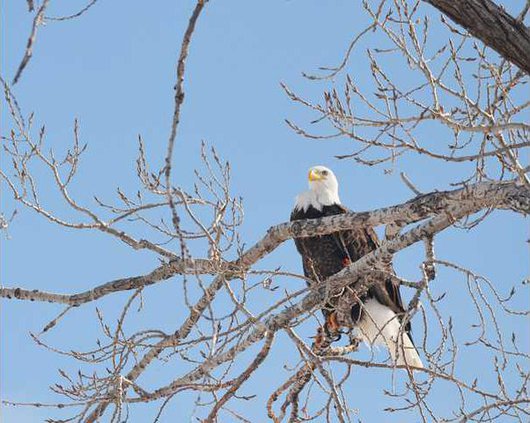Bald eagle facts:
• Size - The female bald eagle is 35 to 37 inches, slightly larger than the male.
• Wingspan ranges from 72 to 90 inches.
• Bald eagles can fly to an altitude of 10,000 feet. During level flight, they can achieve speeds of about 30 to 35 mph.
• Several eagles soaring in a thermal together is described as a kettle of eagles.
• Bald eagles weigh from 10 to 14 pounds.
• Eagle bones are light, because they are hollow.
• The beak, talons, and feathers are made of keratin.
• Bald eagles have 7,000 feathers.
• Longevity - Wild bald eagles may live as long as 30 years.
• Bald eagles sit at the top of the food chain
• Lifting power is about four pounds.
• Diet – Mainly fish, but they will take advantage of carrion (dead and decaying flesh).
• The bald eagle is a strong swimmer, but if the water is very cold, it may be overcome by hypothermia.
• Hunting area varies from 1,700 to 10,000 acres. Home ranges are smaller where food is present in great quantity.
• All eagles are renowned for their excellent eyesight.
• Nests are built in large trees near rivers or coasts.
• An eagle reaches sexual maturity at around four or five years of age.
• Fidelity – Once paired, bald eagles remain together until one dies.
• Bald eagles lay from one to three eggs.
• The bald eagle became the National emblem in 1782 when the great seal of the United States was adopted.
Information from baldeagleinfo.com.
Many Great Bend residents were doing a double take as they drove around the west side of Veterans Memorial Lake Wednesday morning. A bald eagle sat regally perched in a barren tree, carefully surveying the landscape below.
“They are fairly common in the winter,” said Rob Penner, local avian program manager for the Nature Conservancy. The birds, symbols of our nation, follow the migration of the water fowl and feed on the ducks and geese.
However, Wednesday, the geese at Vets didn’t seem to pay much attention to the white-headed visitor.
That being said, they are not all that common in populated areas, shunning cities for rural areas, Penner said. So, this eagle’s appearance at Vets was a rare one.
Penner said the bald eagle numbers in Barton County fluctuates. “They like open water.”
So, if bodies of water are frozen over, they tend to go elsewhere.
Penner said the eagle in Great Bend was an adult. Bald eagles have a distinctive juvenile plumage, then a second year plumage, then a third year plumage before they have this adult plumage.
After looking a picture of the bird, all he could say for sure is that this bird is at least 4 years old. And, since he didn’t see any faint streaking on the head, he guessed it is over 5.
Males and females are identical in appearance, with the females being slightly larger than the male, he said. There are also slight differences in the talons and beak size, but he couldn’t speculate on this eagle’s gender.
Going strong
“Over all, bald eagles are doing really well,” Penner said. They have made a strong comeback since the 1960s and 70s when they were an endangered species.
“Every year, the number of breeding pairs in Kansas is growing,” he said. There is even a nesting pair at Quivira Wildlife Refuge in Stafford County.
None the less, Penner said, they are very striking to see and are quite popular with bird watchers and the public. “People like bald eagles.”
The bald eagle (Haliaeetus leucocephalus), is the national bird of the United States and is the only eagle unique to North America. The bald eagle’s scientific name signifies a sea (halo) eagle (aeetos) with a white (leukos) head.
According to baldeagleinfo.com, at one time, the word “bald” meant “white,” not hairless. Bald eagles are found throughout most of North America, from Alaska and Canada to northern Mexico.
About half of the world’s 70,000 bald eagles live in Alaska. Combined with British Columbia’s population of about 20,000, the northwest coast of North America is by far their greatest stronghold for bald eagles. They flourish here in part because of the salmon. Dead or dying fish are another important food source for all bald eagles.
Eagles are a member of the accipitridae family; which also includes hawks, kites, and old-world vultures. Scientists loosely divide eagles into four groups based on their physical characteristics and behavior. The bald eagle is a sea or fish eagle.
There are two subspecies of bald eagles. The “southern” bald eagle, Haliaeetus leucocephalus leucocephalus, is found in the Gulf States from Texas and Baja California across to South Carolina and Florida, south of 40 degrees north latitude. The “northern” bald eagle, Haliaeetus leucocephalus alascanus, is found north of 40 degrees north latitude across the entire continent.
The largest numbers of northern bald eagles are in the Northwest, especially in Alaska. The “northern” bald eagle is slightly larger than the “southern” bald eagle. Studies have shown that “northern” bald eagles fly into the southern states and Mexico, and the “southern” bald eagles fly north into Canada. Because of these finding, the subspecies of “northern” and “southern” bald eagles has been discontinued in recent literature.
Both male and female adult bald eagles have a blackish-brown back and breast; a white head, neck, and tail; and yellow feet and beak.
On June 28, 2007, the Department of Interior took the American bald eagle off the Federal List of Endangered and Threatened. Bald eagles are still be protected under the Bald and Golden Eagle Protection Act.





